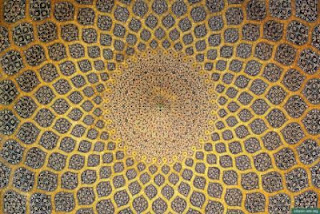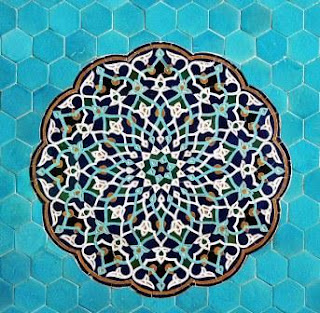 |
| Sheikh Lutf Allah Mosque is one of the architectural masterpieces of Safavid Iranian architecture, standing on the eastern side of Naghsh-i Jahan Square, Isfahan, Iran. Image via: www.IslamicArts.org |
The impact of Persian tiles occupies a prominent place in the history of Islamic art. Recognized for having one of the richest and varied art legacies, Persia (now Iran) used this form of art to decorate palaces, public buildings, monuments, mausoleums, and religious buildings, such as mosques and theological schools.
According to the Iran Chamber Society, “The history of Iranian tile dates back to the prehistoric period. It holds an important position among the various decorative arts in Iranian architecture. The four main decorative features can be categorized here as well. They include stone carving, brick work, stucco and tile panels. Using an intricate method of manufacturing, design and the type of materials used in the four methods mentioned above, the methods have evolved as a result of natural factors, economical and political effects.”
According to the Iran Chamber Society, “The history of Iranian tile dates back to the prehistoric period. It holds an important position among the various decorative arts in Iranian architecture. The four main decorative features can be categorized here as well. They include stone carving, brick work, stucco and tile panels. Using an intricate method of manufacturing, design and the type of materials used in the four methods mentioned above, the methods have evolved as a result of natural factors, economical and political effects.”
It's because of their expertise in handling raw material, and especially because of their artistry, Persian tile makers found themselves in great demand. Their talents were sought in all corners of the vast Islamic empire. Over the centuries, creative artisans used colored stones and brick to create geometric patterns on structures. The rudimentary patterns then developed into natural subjects, such as plants, animals and humans. These masterful creations grace both the interior and exterior of historic Iranian structures.
 |
| A mihrab is a niche set into the middle of the qibla wall of a building in order to indicate the direction of Mecca. (Early 14th century). Image via Los Angeles County Museum of Art (LACMA). |
The art of tile manufacturing reached its peak of perfection and beauty at the end of the 13th century. Moraq tiles (mosaic style) panels created with this technique were made to withstand the elements of time. “Tiles in such colors as yellow, blue, brown, black, turquoise, green and white were cut and carved into small pieces according to a previously prepared pattern,” says the Iran Chamber Society. Further, “These pieces were placed close together and liquid plaster poured over to fill in all the opening and gaps. After the plaster dried and hardened, a large single piece tile panel had been created, which was then plastered onto the required wall of the building. Timurid monuments in Herat, Samarkend and Bokhara were covered by this decorative technique. Among the most famous monuments decorated in this style are the Goharshad Mosque (1418 CE), the Molana Mosque (1444 CE), the Jameh Mosque of Yazd (1456 CE), the Jameh Mosque of Varamin (1322 CE), and the Madrassa of Khan in Shiraz (1615 CE),” the Society added.
 |
| Imam Mosque, Isfahan. Image via www.IslamicArts.org. |
Of the many tile masterpieces found in Iran is the Shah Mosque in Isfahan. The dome of this religious building, which originates from the 17th century, serves as a wonderful example for mosaic tile, as well as cuerda seca tiles. A variety of tile had to be manufactured in order to keep a consistent look throughout its vast halls that were covered in mosaic tile.
 |
| Detail of one of many tiled walls of the Jameh Mosque, Yazd, Iran. Image via www.IslamicArts.org |
Also of importance to the tile-making techniques of the Persian empire was the the Safavid dynasty (1502-1736). It was during this time that ornamental mosaic pieces were often replaced using the haft rang (seven colors) technique. Images were first painted onto plain rectangular tiles, glazed, and then fired. Aside from economic reasons, the seven colors method gave artisans freedom with their creativity, as well as more time to stylize their works of art.
 |
| Situated adjacent to the center of the town of Yazd, the complex of the Friday mosque of Yazd was found in the 12th century. However, what stands on the site today is the new mosque (masjid-i jadid) built in 1324 under the Il Khanids. Image via www.IslamicArts.org. |
It's unfortunate that this glorious form of art wasn't extensively documented throughout the ages. The patterns and designs were a closely guarded secret, and therefore, the techniques were only passed down orally from father to son, or from master to student.
 |
| Vakil Mosque, located in Shiraz, Iran, is a beautiful mosque built in the mid-18th century by Karim Khan. Image via www.IslamicArts.org. |
Sadly, this concludes my exploration of tile through the Middle East. Before I get too old, I would really like to explore the country that I was born in, Turkey, as well as Iran, where my husband was born. The architecture, the history, and knowledge that Islamic nations provided not only to their people, but to far-reaching lands, shouldn't be dismissed.
I hope you enjoyed reading this series as much as I enjoyed researching and writing it. Have you gained a greater appreciation of tile? How would you implement current tile patterns and colors into contemporary or modern designs?




No comments:
Post a Comment